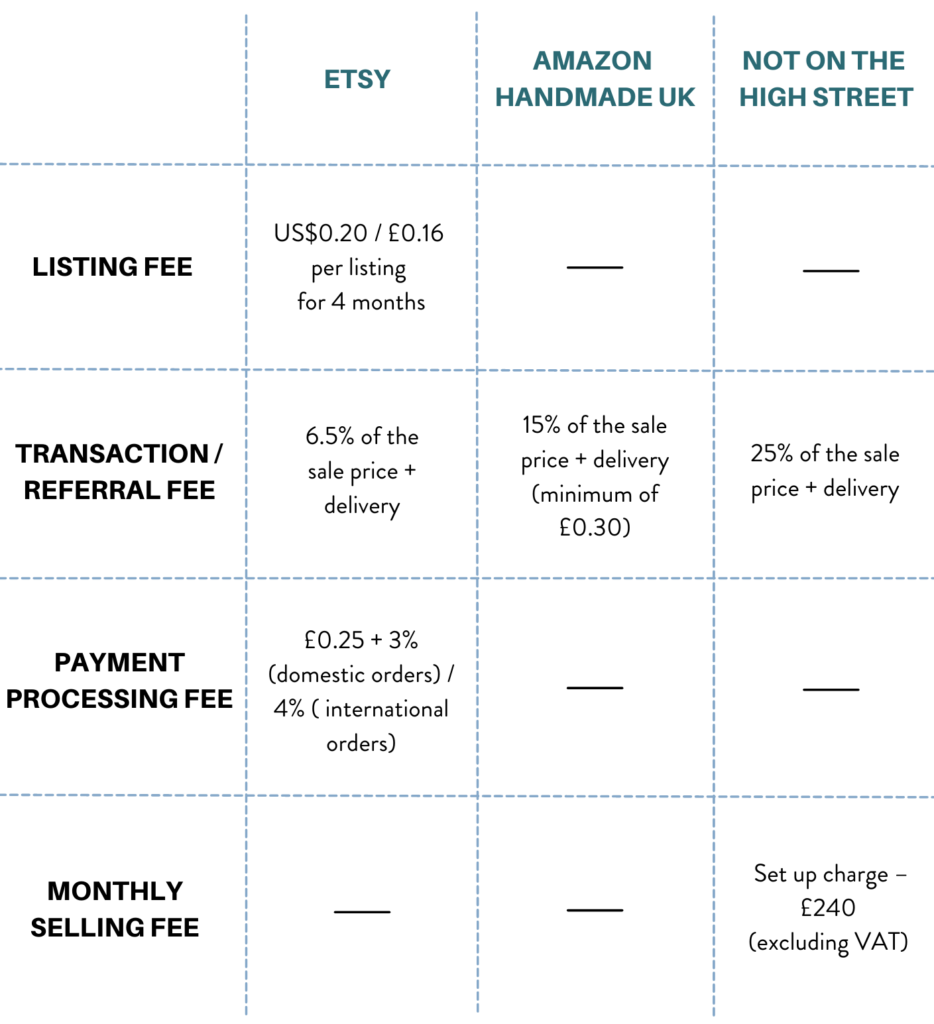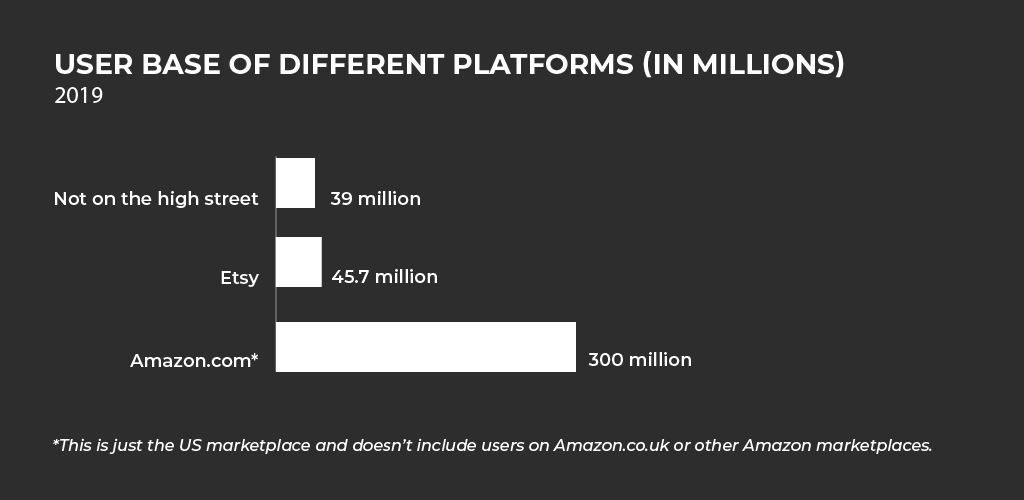Amazon Handmade vs Etsy
But it’s important to do your research when looking at selling on a new platform. Etsy and Amazon Handmade are both handmade marketplaces but that doesn’t mean they play by the same rules. They both come with different pros and cons and require different approaches.
In this post I’m going to look at Amazon Handmade vs Etsy; the major differences between the two marketplaces and what this means for you as a seller.
Definition of handmade
What does handmade mean?
Amazon Handmade and Etsy have different ideas about what is classed as “handmade”.
Amazon Handmade has quite strict rules about what is handmade and what’s not. They have 3 different types of handmade which they’ll accept:
- Handcrafted: Made entirely by hand.
- Hand-altered: Existing products altered or adapted into a new design, for example, a denim jacket you paint or draw your designs on.
- Handmade customized: For example, if you make jewellery and hand stamp initials on them per the customer’s request.
Etsy has a slightly more relaxed definition of handmade. It includes handmade goods, craft supplies (ingredients, materials and tools used to make something) and vintage goods which are 20+ years old.
Who makes the products?
In order to be accepted to sell on Amazon Handmade you will need to be an independent maker, working alone or preferably, with fewer than 20 friends, family members, or employees to create products or a collaborative group or co-operative.
When you apply to sell on Amazon Handmade you have to complete an application process stating which category you fall into and you’ll have to confirm that you do not outsource production to 3rd parties.
On Etsy you can be a maker OR designer:
- Maker: Someone who is physically making the items. You don’t need to be personally making every part of your product, you can incorporate elements that are not handmade and can have help from others.
- Designer: Someone who comes up with the design, template or prototype and then produces the product with an in-house team or through a production partner.
This means that you can outsource the production process to a 3rd party. Note that you still need to have been involved in the designing of the product. It’s NOT considered handmade if you buy scarves wholesale and then resell them in your shop.
Etsy clearly uses a broader definition of handmade but the big difference though is the checking process. On Amazon you will have to prove that your products fit into one of the three handmade categories whereas on Etsy there is no requirement to show how much of your products are actually handmade.
KEY POINT: Etsy allows a broader range of handmade goods on the platform but this is good and bad. You don’t need to go through the verification process you have with Amazon but you’ll be competing against a lot more sellers (and not all of them will be legit handmade sellers).
If you don’t qualify to sell on Amazon Handmade then you could consider selling in another category on Amazon.
Categories
Etsy and Amazon also order their handmade products differently on their sites. Etsy groups handmade products in the following broad categories:
- Jewellery & Accessories
- Clothing & Shoes
- Home & Living
- Wedding & Party
- Toys & Entertainment
- Arts & Collectables
- Craft Supplies & Tools
- Vintage
Amazon Handmade has a narrower range of categories to choose from. These include:
- Handmade Baby
- Handmade Artwork
- Handmade Pet Supplies
- Handmade Toys & Games
- Handmade Home & Kitchen
- Handmade Sports & Outdoors
- Handmade Beauty & Grooming
- Handmade Jewelry & Watches
- Handmade Health & Personal Care
- Handmade Electronics Accessories
- Handmade Stationery & Party Supplies
- Handmade Clothing, Shoes & Accessories
KEY POINT: Etsy accepts a wider range of handmade products than Amazon. This is changing all the time though and Amazon is increasingly offering new product categories within Amazon Handmade.
Fees
A big difference between Amazon Handmade and Etsy is how they structure their fees. Amazon has a reputation for charging higher fees than Etsy and while it certainly takes a larger fee from each product sale (what it calls a referral fee), this is the only fee you pay.
Etsy on the other hand charges a number of smaller fees which all add up. It’s worth looking at how all these fees compare:

KEY POINT: Etsy generally works out slightly cheaper than Amazon Handmade in terms of fees. But it’s important to check how the advertising fees which Etsy has introduced could affect your bottom line.
Payment
Amazon and Etsy also structure their seller payments differently and this can take some getting used to for new sellers. Amazon disperses payments to you every 2 weeks but you can request payments before that time if you need to, providing you have enough funds in your account.
When you sell on Etsy, your funds are available to you as soon as the transaction is completed and you can also request daily disbursements.
KEY POINT: For sellers who require payments to cover the cost of creating new products, being able to access your funds immediately through Etsy can be a real bonus. Having said that I’ve always found the Amazon system useful for forecasting cash flow. Because it’s regular and Amazon shows you in advance what disbursement you can expect, it’s easy to plan.
Competition
Amazon Handmade is far less competitive than Etsy which is a much more mature marketplace in terms of number of sellers. There are actually only 1 million products listed on Amazon Handmade compared to a whopping 60 million products listed on Etsy.
Amazon Handmade is still a relatively new category and that combined with the application process means that it’s really not very competitive yet.
At some point, it may very well be as competitive as some of the more mature categories on Amazon but right now it’s still in its infancy and this offers sellers a fantastic opportunity to get in early. I talk about this in more depth in this video looking at competition on Amazon Handmade.
As I’ve mentioned Etsy allows a broader range of handmade products and types of sellers and this means there is a lower barrier to entry and more sellers as a result.

Fulfilment
One of the perks of selling on Amazon Handmade is Amazon’s FBA programme. When you sell on Amazon you have 2 main options for fulfilling your orders – you can either fulfil your orders yourself from your location (known as Fulfilled by Merchant or FBM) or you can pay Amazon to fulfil your orders for you (known as Fulfilled by Amazon or FBA).
Fulfilled by Merchant (FBM)
If you choose Fulfilled by Merchant you will be responsible for storing your products, packing and shipping them to your customers, as well as handling returns. If your products are customised or made to order then this is the fulfilment option you would choose.
To help with managing your orders, Amazon allows handmade sellers to set production times in your listings so that customers have a clear timeframe for when they can expect their products, giving you plenty of time to produce and send the products.
Fulfilled by Amazon (FBA)
One of the major advantages of selling on Amazon is that you get access to Amazon’s amazing fulfilment network through the FBA programme.
If you sell via FBA, then Amazon takes care of product storage, packing, shipping and returns. You simply ship your products in bulk to Amazon’s distribution centres and from there Amazon will take over distributing products to customers and handling returns.
If you use the FBA programme then you will pay an FBA fee and storage fees and these will be automatically deducted from your payments from Amazon.
The fees for selling via FBA often work out cheaper than storing and sending products to customers yourself, plus it’s a lot less work! If your products are fulfilled via FBA then they will also be eligible for Prime which gives you a significant advantage over sellers who don’t offer Prime delivery.
Many customers will specifically look for sellers offering Prime delivery/free shipping, particularly during busy buying periods like Christmas, so you have the potential to make a lot more sales
Using FBA also means that you can easily sell your products in international markets regardless of where you are based.
Through Amazon FBA, a UK based seller can sell on Amazon.com and sell products to US customers by shipping products in bulk to an Amazon distribution centre in the US. This is what I do, and it’s incredible when you think about it.
This is a really easy way for sellers to expand their business and build a global customer base without all the challenges that come with building an international fulfilment network. It can be absolutely game-changing for a small business.
On Etsy, you are 100% responsible for storing and shipping your products to customers. Selling to customers in international markets can be very expensive and time-consuming and doing it at scale is simply not an option for a lot of handmade sellers.
Application process
As I’ve mentioned you have to go through an application process to sell on Amazon Handmade and so it can take longer to get set up than it would on Etsy. On Etsy there is no verification process, you just enter your details and you can start selling almost immediately.
For more information on Etsy, check out my guide on how to set up an Etsy shop.
The application process for Amazon Handmade takes a bit longer and you also need to register for an Amazon seller account if you don’t already have one.
First you need to create a professional seller account – this can take a bit of time but it’s pretty straight forward (I cover this in detail in this comprehensive guide to getting set up on Amazon Handmade). Once you’re registered as a seller then you can sign up to sell on Amazon Handmade.
Before you begin, log out of your Amazon account and make sure you have the following ready:
- A short summary (around 120 words) describing how you make your products and what materials you use.
- Images of your products, production area and process in JPEG format
Then start working through the multiple choice questions about you, your products and your production process before uploading your summary and images. If you would like some help with creating your summary, download my Amazon Handmade application template here.
You should hear back from Amazon within a couple of days although it can take up to 2 weeks sometimes, so don’t panic if it takes longer!
Summary
It’s really important to diversify your business so you’re not reliant on one platform. Amazon Handmade and Etsy are both great places to sell your handmade products and they both have different advantages.
For example you might like Etsy for it’s faster payment terms while you might find Amazon Handmade’s FBA programme really useful for growing your business.
Make sure you weigh up the pros and cons and adapt your approach so you make the most out of both marketplaces.
If you found this interesting, you might like my in-depth video on Etsy vs Amazon:

3 thoughts on “Amazon Handmade vs Etsy: What’s the difference?”
Pingback: How to sell on Etsy in 2022 - Teddy Smith
Pingback: How much does it cost to sell on Etsy - Teddy Smith
Hi there! This article couldn’t be written much better! Reading through this post reminds me of my previous roommate! He always kept preaching about this. I am going to forward this article to him. Pretty sure he’ll have a very good read. Thank you for sharing!